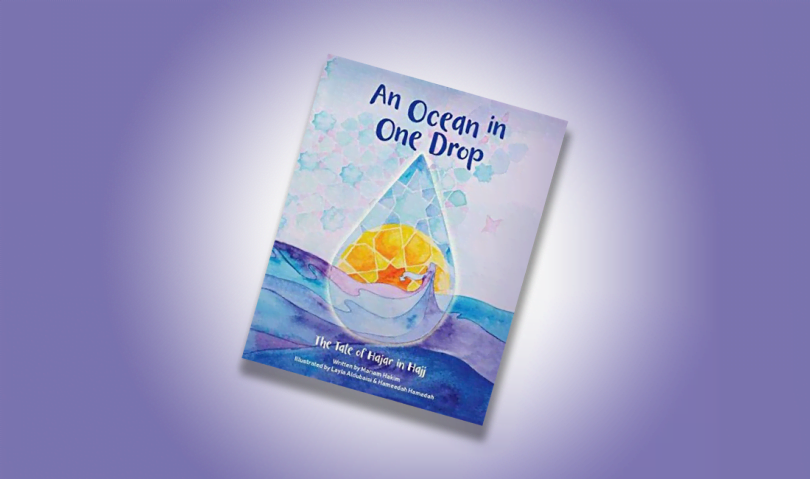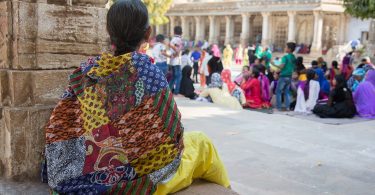Mariam Hakim is Founder of Waw Stories, a new publishing imprint set to profile powerful tales from Muslim and Middle Eastern cultures, and has been a media and communications consultant for many years working within the charitable sector for interfaith and youth sector organisations.
Mariam has written about faith, interfaith and gender for the Huffington Post, The Independent and The Muslim Vibe. Today I’ll be talking to Mariam about interfaith work, her own faith, and her new book for children, An Ocean in One Drop.
Hi Mariam, thanks for agreeing to do this interview with me. You’re clearly very involved in interfaith work, but first I’d like to ask you about your own faith background. What has your faith journey been like? And, how has this led you to become so involved in interfaith activism?
I was born into a praticising Sunni Muslim household and went to a Church of England faith school in London, which I feel gave me a good foundation for appreciating the Divine and connecting with my spiritual side! Growing up Muslim in the UK and going to a Church school gave me a deep understanding of the importance of interfaith dialogue, the need for better bridge-building between people of different faiths and the communities that they belong to. My interest in interfaith stemmed from this early experience of connecting my Muslim heritage with the Christian framework in which I was schooled, and also within a society that claims Christian heritage… and I’ve been passing this on through my writing and now on to my own children. For example, I’ve found that Christmas is a fantastic time of year to reflect on the Islamic nativity story and Mary(am)’s birth journey. How and why it differs gives us lots of food for thought that can be applied to the here and now.
Are there any tips you would give to young Muslims, or young adherents of any religion, who want to get involved in interfaith work?
Be brave and be open to learning about lessons and morals from all faiths. At the same time feel sound in knowing that it’s ok to value what makes you all different and unique. There are many paths to truth. So be comfortable in your truth and respect that others have their own. It’s ok to ask challenging questions at interfaith activities, but my tip is not to be too confrontational. It never works out well. Interfaith events should always be a space to learn and grow… not to shoot people down. It probably helps to have some house rules at the start of any activity. I’ve met some people over the years that have been raised in a very set frame of mind when it comes to religion and spirituality, almost as though they have a monopoly on the Divine. Unfortunately, I’ve seen attitudes of religious supremacy and I genuinely believe engaging in interfaith work is also about unlearning some of these bad habits that make us treat other humans with less respect than they deserve. That is, after all, the antithesis of what most faiths preach!
Do you think there are any limits to how far interfaith activity can go? Some Christians that I know are happy to work with and for other “People of the Book” – Christians, Muslims and Jews – but not other faiths. What is your response to that?
Yes, I do feel everyone has limits, but it’s important for us to understand what those limits are first and why. The great thing about engaging in interfaith activity is that it rigorously challenges your own understanding of religion and faith in a healthy way. Diverse social contact is healthy. Religious literacy and interfaith literacy is healthy. There’s a saying: ‘sapere aude!’ or ‘dare to know’. We should never shy away from thinking for ourselves, this is why most people come to university and it’s healthy to question and solidify our own beliefs.
Ironically I’ve found in the process of engaging in interfaith dialogue and activism, that I’ve ended up learning more about my own Muslim background and about the Islamic faith than I thought I would. It’s a process that changes you and refines your own spirituality rather than taking anything away from you. I’ve met many adherents of different faiths that feel suspicious of any sort of interfaith activity. They think engaging in interfaith work is a trojan horse for converting people, but this is not the case. True interfaith dialogue is about being open, honest and ethical with other humans. Being able to have interfaith conversations and take on interfaith learning is an asset to your spiritual side, not a loss.
In your work, you harness the power of storytelling to both show the similarities between different faiths and to demonstrate what Islam is really about, rather than what the tabloid media try to depict it as. How do you go about choosing which stories to tell, and how to tell them?
I’m interested in under-represented stories, the ones that are pushed to the peripheries and yet are hiding in plain sight. I’m interested in why they are being buried – and often this spurs me on to try and change this (if I can!). I feel that stories that have stood the test of time despite human politics are all the more powerful and that’s the ones that draw me in. Often it is under-represented stories that can help to re-orientate perspectives. How do I tell stories? Well, I like to tell stories in layers, hopefully people can see that in my writing and the illustrations I curate – together they form a rich tapestry of tales for people to reflect on. In my children’s book, I utilised a traditional female Arabian art called ‘Al Qatt Al Asiri’ across the desertscape, this was to add a homage to this indigenous artform and also celebrate women’s stories.
Right now, I’m focussing on Islamic women’s stories from sacred sources, there are so many great ones that haven’t had the limelight they deserve. Sometimes I’m not sure if I’m the one choosing the stories, or if the stories are choosing me. Ultimately a universal truth will always find a way to come back to the fore by itself, it’s only just a matter of time!
Most religions, but particularly Islam, are seen as patriarchal and to some extent, oppressive. Is there any way, other than telling stories like you do, to challenge these perceptions? Or, is the best thing to do to simply provide balance to depictions of Islam and other religions in the media?
I believe the greatest thing anyone or any type of people can do is to tell their own story, to vocalise their own truths, and my writing and my children’s books are exactly about that. I genuinely believe that if people can value women’s stories better and Muslim stories better then it will be normalised for them to value these people better. There is a cause and effect in order to change a mentality and I believe that storytelling is at the heart of everything that we do. There are numerous ways to do it, I just happen to love writing as a form of expressing myself. I think whatever you do to try and change perceptions and provide balance, make sure there’s a good story behind it and a good storytelling method.
Where do you think the focus of interfaith work should be? In schools or universities to educate children and young adults when they are still open-minded? Or do we need to focus on challenging adults about their prejudices and misunderstandings?
All aspects of society and ages are relevant. For years I’ve written for adults, it’s just that recently I realised that some of the reflections I had to share were not accessible to very young children, and that it was equally important to bring them into the fold in an accessible way. Hence why I wrote a children’s story book.
Your new book, An Ocean in One Drop, focuses on the narrative of Hajar and her struggle to find water for her son – a narrative celebrated by the Hajj pilgrimage within Islam. Are there any other women, within Islam or from other faith traditions, who you are inspired by?
Nice summary! Yes, there are countless, but in particular I have had a passionate interest in many of the ancient Arabhamic interfaith female figures, such as Mary(am), Bilkees (Queen of Sheba), the two mothers of the prophet Moses etc. I want people to think carefully about their stories, because they have been given prominence across scriptures. In the Islamic tradition these women are marked out as exemplary females, their stories should be venerated and honoured, but alas, misogyny and sexism has devalued their stories over time so the tales aren’t retold much.
I’m also interested in how their stories are told differently across the Abrahamic faith traditions – and how this can give us an understanding of how the Sacred Feminine is expressed across different faith traditions. An Ocean in One Drop is the first in a series of stories that will focus on female figures from Islamic sacred sources, exploring the power in their narratives and what we can take from their deeply spiritual journeys.
Mariam’s first venture into childrens publishing, An Ocean in One Drop, is now available across selected books stores and online. If you want to know more about Mariam’s work, follow her @mariamKSHakim or @WawStories.









